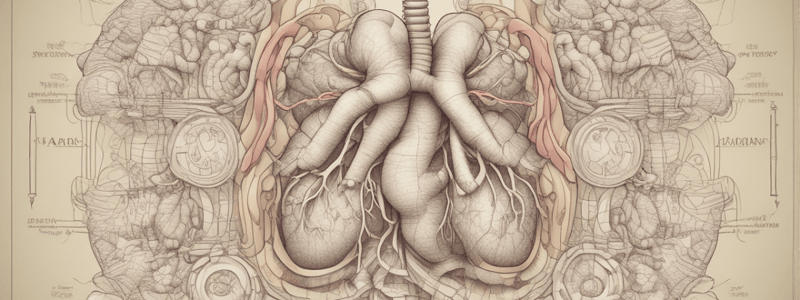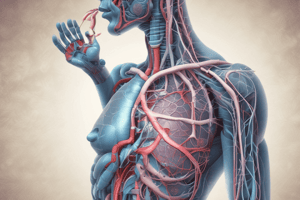Podcast
Questions and Answers
What is the process of gas exchange also known as?
What is the process of gas exchange also known as?
- Oxygenation
- Exhalation
- Inhalation
- Respiration (correct)
What determines the movement of gases?
What determines the movement of gases?
- Humidity
- Temperature
- Partial pressure (correct)
- Atmospheric pressure
What happens to the chest when we take a deep breath?
What happens to the chest when we take a deep breath?
- It expands (correct)
- It remains the same
- It deflates
- It contracts
Why do our lungs expand when our chest contracts?
Why do our lungs expand when our chest contracts?
What happens to the abdomen when we take a deep breath?
What happens to the abdomen when we take a deep breath?
What is the direction of gas diffusion?
What is the direction of gas diffusion?
What is the function of the fluid between the double membrane surrounding the lungs?
What is the function of the fluid between the double membrane surrounding the lungs?
What happens to the volume of the thoracic cavity during normal expiration?
What happens to the volume of the thoracic cavity during normal expiration?
What is the primary mechanism of oxygen transport in the blood?
What is the primary mechanism of oxygen transport in the blood?
What is the percentage of carbon dioxide transported by being dissolved in plasma?
What is the percentage of carbon dioxide transported by being dissolved in plasma?
How many molecules of oxygen can each haemoglobin molecule carry?
How many molecules of oxygen can each haemoglobin molecule carry?
What is the percentage of oxygen that is transported dissolved in plasma?
What is the percentage of oxygen that is transported dissolved in plasma?
What determines the blood's saturation?
What determines the blood's saturation?
What is the percentage of haemoglobin saturation at normal PO2 levels?
What is the percentage of haemoglobin saturation at normal PO2 levels?
Approximately how many breaths do humans take in their lifetime?
Approximately how many breaths do humans take in their lifetime?
If we could lay out the tiny tubes that make up our lungs, they would take up the size of:
If we could lay out the tiny tubes that make up our lungs, they would take up the size of:
What is the main focus of the study of the mechanics of breathing and gas exchange?
What is the main focus of the study of the mechanics of breathing and gas exchange?
What is the purpose of the respiratory membranes in the lungs?
What is the purpose of the respiratory membranes in the lungs?
What is unique about the experience of having lung disease?
What is unique about the experience of having lung disease?
What changes in our anatomy when we laugh, cry, yawn, or hiccup?
What changes in our anatomy when we laugh, cry, yawn, or hiccup?
What happens when diffusion of gases between the alveoli and blood is impaired or oxygen transport in the blood is altered?
What happens when diffusion of gases between the alveoli and blood is impaired or oxygen transport in the blood is altered?
What is a common result of obstructive lung disease and restrictive lung disease?
What is a common result of obstructive lung disease and restrictive lung disease?
What can cause reduced ventilation in the respiratory system?
What can cause reduced ventilation in the respiratory system?
What is the purpose of sneezing?
What is the purpose of sneezing?
What happens when the receptors in the respiratory tract are stimulated?
What happens when the receptors in the respiratory tract are stimulated?
What is pneumothorax also known as?
What is pneumothorax also known as?
What causes the 'hic' sound in hiccups?
What causes the 'hic' sound in hiccups?
What is a consequence of ventilation/perfusion abnormalities?
What is a consequence of ventilation/perfusion abnormalities?
What is the role of receptors in the nose in relation to sneezing?
What is the role of receptors in the nose in relation to sneezing?
What is an important function of haemoglobin in the body?
What is an important function of haemoglobin in the body?
What is the purpose of the brain's response to receptor stimulation in the respiratory tract?
What is the purpose of the brain's response to receptor stimulation in the respiratory tract?
What is the result of the diaphragm's contraction in hiccups?
What is the result of the diaphragm's contraction in hiccups?
Flashcards are hidden until you start studying
Study Notes
The Respiratory System
- The human respiratory system allows us to take in oxygen and remove carbon dioxide from our bodies.
- In a lifetime, we take around 600 million breaths, and if we laid out the 750 million little tubes that make up our lungs, they would cover the size of a tennis court.
Gas Exchange
- Gas exchange, also known as respiration, is the uptake of oxygen from the atmosphere and the discharge of carbon dioxide back into the environment.
- A particular gas within a mixture of gases exerts a pressure, known as partial pressure.
- Gases always diffuse from a region of high partial pressure to a low partial pressure.
Breathing
- When we take a deep breath, air rushes in through the nose or mouth, the chest expands, the abdomen expands slightly, and the shoulders may lift up.
- This is due to negative pressure breathing, where the pressure must be lower in the lungs to pull air in.
- The chest expands due to muscle contraction, which creates a lower pressure inside the lungs.
Lung Expansion
- The lungs expand when the chest contracts due to a double membrane surrounding the lungs, which creates a surface tension that easily sticks together but doesn't easily pull apart.
Expiration
- Breathing out, or expiration, is a passive process that does not require muscle contraction.
- When the diaphragm and rib cage relax, the volume of the thoracic cavity reduces, driving air out of the lungs.
Lung Volumes and Capacities
- We can alter the volume within our lungs.
Gas Exchange at the Alveoli
- The human lungs contain millions of alveoli, creating a huge surface area for gas exchange.
- Oxygen diffuses rapidly across the membrane into the surrounding capillaries for dispersal around the body.
Gas Transport in the Blood
- Oxygen is predominantly transported around the body bound to haemoglobin within red blood cells (98%).
- Carbon dioxide is transported by three different mechanisms: 7% dissolved in plasma, 23% bound to haemoglobin, and 70% converted to bicarbonate.
Oxygen Transport by Haemoglobin
- Each haemoglobin molecule can carry four molecules of oxygen.
- The blood's saturation depends on how much oxygen is bound, with 100% saturation occurring when all binding sites are occupied.
Oxyhaemoglobin Saturation Curves
- At normal PO2 levels, haemoglobin is 98% saturated.
- Minor changes in PO2 do not have a significant effect on the saturation.
When Things Go Wrong
- Impaired diffusion of gases between the alveoli and blood or altered oxygen transport in the blood can result in hypoxia.
- Two general categories of dysfunction: obstructive lung disease and restrictive lung disease.
- Additional conditions affecting respiratory function include diseases affecting diffusion of oxygen and carbon dioxide, reduced ventilation, failure of adequate pulmonary blood flow, and ventilation/perfusion abnormalities.
Involuntary Responses
- Sneezing: receptors in the nose send a signal to the brain to close off the mouth and force air out of the lungs through the nose to expel irritants.
- Coughing: receptors in the respiratory tract send a signal to the brain to close off the glottis and vocal cords, building pressure in the lungs and forcing air out when muscles contract.
- Hiccups: a trigger leads to involuntary contraction of the diaphragm, closing off vocal cords briefly, causing air to "bounce" off them, creating the "hic" sound.
Studying That Suits You
Use AI to generate personalized quizzes and flashcards to suit your learning preferences.




